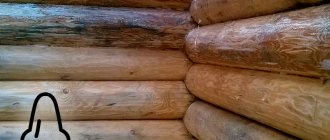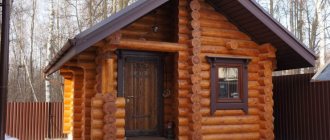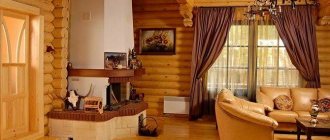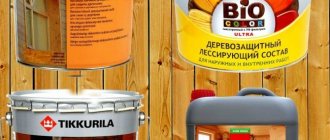The basic building material for a bathhouse, which is used most often, is wood. At the same time, panels and timber are flammable; they are not always able to cope with numerous negative factors. They are spoiled by pests, microorganisms, and mold and mildew may appear. In addition, it is in the sauna and bathhouse that there is extremely high humidity and sudden temperature changes. That is why the best solution is complex impregnation with special protective compounds. Today we are going to take a closer look at the processing features, composition characteristics, rules and recommendations from experienced experts and craftsmen.
View this post on Instagram
Post from Vesuvius 68 Tambov (@vesuvius68tambov)
We choose with optimal criteria
Wood has numerous advantages, but its vulnerability cannot be discounted. Thus, it is this building material that is most susceptible to the negative effects of moisture. Over time, wooden panels dry out and become deformed, and may begin to rot. Microorganisms, mold and pests also pose a great danger.
View this post on Instagram
Publication from Construction and finishing of baths (@leshy_style)
The most negative operating conditions are undoubtedly in the steam room. When the temperature changes sharply, condensation forms, and humidity reaches peak values, all this has an extremely negative effect on the tree and stimulates its destruction. If we talk about special protective impregnations, then their help is not as clear as it might seem at first glance. Thus, standard formulations under the direct influence of moisture and high temperature can begin to release harmful chemical compounds. And for such a premises, environmental cleanliness and one hundred percent safety are a mandatory requirement.
Important. Another significant point. People stay in the steam room for a long time, and their bodies come into direct contact with wooden surfaces: benches, shelves, floors and walls. Accordingly, all these materials and surfaces must be absolutely safe and pleasant for contact with the body. Each such factor must be taken into account when choosing specific impregnating compositions.
Here are a few points to consider when choosing impregnating protective compounds for your sauna:
- Consider which specific part of the steam room the product is intended for. If necessary, check everything with the seller and study the instructions from the manufacturer.
- The method of applying the protective agent also plays a role. You can use sprayers and rollers, as well as brushes.
- Consider the order in which processing will occur. It matters for the application of the composition whether this impregnation becomes primary or it turns out to be finishing.
- Be sure to consider whether painting of wood surfaces is planned at the final stage of finishing.
It makes sense to use only those compounds that are adapted specifically for use in a bathhouse or sauna. If you use a standard protective impregnation for wood, you will only waste money and time on work, since you still won’t get the desired result.
Sauna wax
The best and most effectively used means for protecting wood in a sauna are special ready-made waxes. Such compositions include natural ingredients. The products create a thin protective film, which simplifies maintenance and removal of contaminants and, of course, extends the service life of the lining.
The best and most effectively used means for protecting wood in a sauna are special ready-made waxes
Sauna wax 290 Hartwachs from Gnature
Sauna wax 290 Hartwachs from Gnature is a heat-resistant wax that is frequently exposed to moisture and temperature. This is a colorless coating that creates a protective film on the surface. The product is ideal for shelves and benches. Hartwacs 290 wax can be purchased in 250 ml capacity. One can is enough for 20 m2 in one layer, and that’s enough.
Special wax for baths and saunas TEKNOVAX 1160
Special wax for baths and saunas TEKNOVAX 1160 is intended for treating wooden surfaces in steam rooms and other wet rooms. This water-borne, environmentally friendly composition does not contain harmful components and is odorless.
The composition is easily and quickly applied, forming a water-repellent film that can withstand changes in temperature and humidity and has excellent adhesion, so the coating does not peel off. The composition dries quickly enough, so the rooms painted with it are ready for use the very next day after treatment.
Typical impregnation features for different parts of the room
Some owners do not want to spend too much time and effort on selecting protective components. As a result, they choose one product with which they treat all parts of the room, the entire bathhouse from the inside. This can also be done, but this is far from the best solution. It is advisable to take into account that operating conditions in different parts of the bathhouse differ significantly. If you pay attention to this, then the processing will be maximally adapted to specific parameters.
Let's start analyzing all surfaces. We will try to derive optimized rules for protecting sauna impregnations in accordance with the type of zone.
Ceiling
Experts and craftsmen note an interesting point: steam and hot air rise to the ceiling, but at the same time there are not so many requirements for the surface when compared with other zones. Here we take into account the influence of high temperatures, which is typical for all areas and surfaces in the sauna. A good solution is to cover the ceiling with high-quality specialized varnish, which is produced specifically for use in bathhouses or saunas.
Walls
The largest part of the composition will be spent on protection from all the negative effects of the lining with which the walls are sheathed. Here are the two most significant factors. Be sure to take them into account:
- You cannot cover the walls with impregnations that will not allow the wood to “breathe”. This will provoke premature aging of the material, as well as its deformation.
- Varnishes and impregnating compositions must be completely safe for human health and environmentally friendly. Such products, even with extreme heating, do not emit unpleasant odors or harmful chemical compounds.
As experts with extensive experience note, it is better not to try to save money on such impregnations. If you purchase an untested product, you can provoke rapid aging and damage to the wood, which will entail large expenses in the near future.
Floor
It is the floor surface that is exposed to maximum negative influences in the bathhouse. This is especially true for the steam room. Almost all the water that is used here ends up on the floor. And it is protection from water that will require maximum attention. In addition, we must not forget about powerful antibacterial protection.
Experts immediately remind us of a protective varnish coating for the floor. There are also quite a lot of requirements for it, determined by the operating conditions in the sauna. Let's look at a few of the most significant factors:
- The tree must be able to “breathe”. Therefore, a professional product that is not in the lowest price category is suitable.
- There is no need to apply several layers of varnish. There is a common misconception about the increased strength of multilayer coatings. But this is a misconception: with repeated layering, the varnish coating becomes cracked much faster. They can be invisible and small, but at the same time they will allow water to pass through and jeopardize the safety of the tree.
- The protective layer of varnish, of course, should not slip, as this can lead to injury in the sauna.
- Some varnishes are simply not designed to withstand extremely high temperatures, so they may begin to stick when heated. Of course, this option is also absolutely not suitable for a bathhouse.
Another expert tip. Already at the stage of constructing a bathhouse, it is necessary to take care of the impregnation of the logs themselves, on which the floor boards will then be laid. They are also impregnated with protective compounds to maximize the service life and preservation of the wood.
Benches, shelves
View this post on Instagram
Publication from Alexey (@drevostroy)
The shelves are the most significant part of the entire steam room. It is important that the shelf is not only comfortable, but also completely safe for health and environmentally friendly. Therefore, maximum attention is paid here to the quality of protective impregnating compounds.
Let's start with temperature. Wood itself is a poor conductor of heat. Even if you lie on a tree at an extremely high temperature, you will not get burned. But if the tree is covered with an unsuccessful protective film, it may well cause serious thermal burns when it comes into contact with the body. This is precisely why experienced craftsmen note: it is undesirable to use varnishes and paints here for processing. The best solution is to use the appropriate impregnation, adapted specifically for the bath. In most cases, such protective compounds are made on a wax basis.
Interesting point. Nowadays, the requirements for environmental cleanliness and comfort are often so high that the owners insist: the shelves in the bathhouse must be completely natural. That is, the wood is not impregnated at all. This is possible, but such an approach implies regular replacement of these elements, since they will certainly quickly deform and the tree will age quickly.
When a bathhouse or sauna is decorated very well, the interior is thought out, powerful wooden panels are used, there is a desire to preserve it all longer, to maximize its service life. And here, undoubtedly, you can’t do without impregnation.
Finishing of “dry” rooms in the bathhouse
When decorating a rest room, hall, bedrooms and other rooms in a bathhouse with a normal microclimate, wooden surfaces can be treated with Osmo bath wax oil.
- Floor.
To obtain a beautiful visual effect, use transparent oil “Dekorwachs Transparent Tone” and bright colors from the “Dekorwachs Intensive Tone” line. The toner is applied in two layers with a break of 12 hours. As a finishing coat, one layer of low-wax with an anti-slip effect “Hartwachs-Ol Anti-Rutsch” is recommended. - Walls and ceiling.
Surfaces are treated with colored or transparent oil from the “Dekorwachs” series. As a finishing coat, oil with hard wax “Hartwachs-Ol Original” is used.
When using softwood lumber, which is prone to blue staining, for finishing dry rooms in a bathhouse, a hydrophobic composition “Osmo Holzprotektor” is needed. Before installation, lumber is immersed in the solution for 2 minutes, which provides reliable protection against rotting and blue staining.
Protective impregnations, their features
Now we have to look at several of the most widely used impregnation compositions. Let us dwell in more detail on their features, operational properties and characteristics.
You can start with drying oil, since for many years it was the one that was the leader in terms of mass use. However, at the moment, such a remedy is definitely a thing of the past. Previously, all surfaces in the bathhouse were covered with drying oil, and it was also valued at a minimal cost. But in terms of protection efficiency, it is definitely inferior to all proven modern compounds. In addition, when heated, drying oil emits an extremely unpleasant odor, which will definitely spoil the atmosphere in the bathhouse.
Now we will look at high-quality modern bath impregnations.
Oil compositions, varnishes
Such impregnations can reliably protect wooden surfaces from the negative effects of moisture. They create a durable protective film, while at the same time allowing the wood to “breathe”. But the unpleasant odor that appears during operation becomes a significant disadvantage here. Experts do not recommend using such compounds in the steam room. But for external treatment, when protecting wood in the waiting area and rest room, such products are quite suitable.
Water-based dispersion impregnations
A significant advantage of such compositions is that they are water-based. This production principle allows impregnations to penetrate deep into the wood structure. They are maximally resistant to excessively high temperatures and temperature changes; they are completely free of active chemical compounds. When heated strongly, they do not emit any harmful chemicals at all.
The range includes colorless impregnations, as well as compositions with the addition of coloring components. Another plus is the presence of antibacterial components in some impregnations.
There are also disadvantages. And this is primarily the fragility of the protective layer. It is recommended to do this impregnation again every year, since with active use of the bathhouse, the water-based composition will simply be washed out of the wooden surface.
Wax impregnations
Purely wax compositions are practically not used at the moment. But products with the addition of wax as a component are an excellent option. This composition will reliably protect the tree, and will also additionally give it a pleasant shine. The products are also very convenient to apply and are in the middle price category.
Osmo oils
A large German company produces a series of products based on natural oils. This:
- Refined sunflower oil.
Included in products for walls and floors. - Flaxseed oil for baths.
This can be a mono product based on linseed oil, which is subjected to prolonged heating. Impregnating the bath with linseed oil provides protection from moisture and a beautiful appearance. - Osotovoye.
This is a premium quality oil, after application of which the wood acquires a silky glossy appearance. - Soy.
Used as a base when creating oil impregnations for baths.
Sauna wax Supi Saunavaha
The SUPI family offers a variety of products for treating saunas and baths. Choose Supi Saunavaha wax if you want to maintain the natural wood look of your entire sauna. Wax can be used to treat benches, walls, panels and ceilings, as well as doors and window frames. Supi Saunavaha contains natural wax, which is well absorbed into the wood, protects the surface and gives it a beautiful, smooth and silky shine.
Supi Saunavaha belongs to environmentally friendly materials of class M1. The composition is practically odorless and does not emit substances harmful to health into the air even when heated. Waxed surfaces are easy to keep clean.
The SUPI family offers a variety of products for treating saunas and baths
Mix Supi Saunavaha wax thoroughly before use, and stir periodically during work. Apply one coat in the direction of the wood grain in such a quantity at a time that the wood can absorb it. Since the material is liquid, it is easier to apply the required amount using a foam brush or sponge. If too much is applied the surface will become slippery.
When using tinted material, it is recommended to carry out a test painting in an inconspicuous place. The properties of different types of wood affect the final color of the surface. It is advisable to process the surface continuously from edge to edge, and when processing large panel surfaces - 1-2 panels at a time to avoid differences in shade. Before use, heat the bath and then ventilate well.
To pour or not to pour
A familiar dilemma: how to treat the shelves in the bathhouse or not treat it at all? The bathhouse is a stronghold of all that is pure and natural; any treatment with an uncharacteristic substance will immediately upset the idyllic balance, but sometimes it is impossible to leave the elements of the steam room without treatment. What should I do? First, let’s determine what negative factors affect wood and what the consequences are:
- In a traditional bath, the wooden elements of the shelf are exposed to high - 60-70 degrees Celsius, and high - over 70 degrees Celsius, temperature and absolute humidity, which in a steam bath can reach 75-80%. In addition, during the cold season, these same shelves are subject to alternating temperature influences. All this is fraught with linear vibration of the wood mass, which clearly causes disruption and, over time, destruction of its structure.
- High humidity is a paradise for microflora, and the moderate temperature observed in a steam room during periods of inactivity in the bath provokes the active development of colonies of microorganisms. Ultimately, they also destroy the tree, just like temperature fluctuations, but they do it faster and more obviously.
- Wood, over time, even in relatively favorable conditions, changes its original color, it becomes darker, and the pattern fades, the texture becomes less pronounced. Where the body rests, the eyes should also rest pleasantly, so the visual state of the interior is an important factor in maintaining the overall favorable “tone” of the bathhouse.
- Finally, the most key and aesthetically unpleasant factor. In conditions of high temperature, a person sweats intensely, and this is a natural and obviously beneficial effect of a bath. But the sweat-fat secretion is intensively absorbed into the thickness of the wood and over time becomes a breeding ground for microorganisms and, as a result, an unpleasant odor in the room.
In principle, the idea with replaceable shelves is good, however, it requires a well-thought-out design of the lid so that replacement is not difficult and occurs quickly and efficiently and, naturally, consumables made from commercial wood of decent quality are always available both in availability and price.
If this option is not possible, then it remains to carry out comprehensive protection of the product.
Тikkurila sauna wax supi saunavaha
The protective composition of Tikkurila Supi Saunavaha was specially designed to protect: shelves, walls, ceilings, doors and window frames inside saunas and baths, from fungal and mold organisms, rotting and drying out. Prevents wood from cracking.
High-quality protective composition Supi Saunavaha Tikkurila 0.25l. It contains natural wax, which reliably protects wood from moisture, dirt and damage. Wax, having been absorbed into the wood, forms a natural water- and dirt-repellent layer on the surface.
Protective wax for Tikkurila Supi Saunavaha wood has three ready-made color solutions: white, black and gray, as well as a tintable composition that can be tinted in colors 3441–3451 according to the catalog “Tintable varnishes for interiors”.
Protective wax for Tikkurila Supi Saunavaha wood is completely natural. It belongs to class M1 material, which means that the paint and varnish material does not emit or emit extremely few volatile substances into the indoor air.
Bath sauna oil wax is manufactured and used as an ecological bioprotection for baths and saunas
Products for treating steam room elements
All products used to process wood inside a bathhouse are divided into two groups: impregnating and coating agents. They are also often divided into colored and colorless, for example, wax, varnish and some impregnations.
Less common are bleaching agents, which are used in cases where the shelves have already darkened. Next, we’ll talk in detail about specific types of processing agents.











